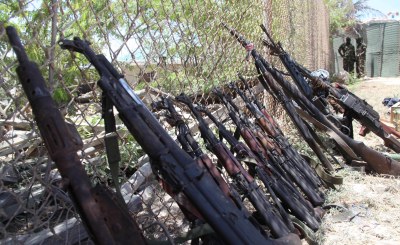-
Somalia: What Drives Al-Shabaab - Foreign Forces Out, Sharia Law in and Overthrow the Government
The Conversation Africa, 11 October 2022
In response to external - and at times internal - pressure, Al-Shabaab's insurgency in Somalia has evolved over time. So have its motivations and goals. Read more »
-
East Africa: Somalia - Lifting Arms Embargo Key to Battling Militants
VOA, 11 October 2022
Somalia is getting support for its campaign to have an arms embargo lifted after Ethiopia joined Uganda in backing the action. The U.N. Security Council is set to vote in November… Read more »
-
Somalia: Al-Shabaab Attacks Pro-Government Militia in Hiran
Shabelle, 11 October 2022
A heavy battle between the Somali army along with locals and Al-Shabaab was reported in El-Ma'an area located on the outskirts of Jalalaqsi town. Read more »
-
Somalia: A Somali District Administrator Killed in Explosion
Shabelle, 11 October 2022
Qoryooley district administrator was killed in an explosion in the district, as confirmed by the authorities of the Lower Shabelle region. Read more »
-
Somalia: Somali Troops Kill 19 Militants in Repelled Al-Shabaab Attack
Shabelle, 7 October 2022
BAL'AD [SMN] - Somali National Army killed 19 Al-Shabab members in a repulsed attack at an army base near Bal'ad district in the Middle Shabelle region, on Friday morning. Read more »
-
Somalia: Somali Army Kills Militants and Commander in Anti-Al-Shabaab Push
Shabelle, 8 October 2022
JANALE [SMN] - Somali military claims to have killed a senior Al-Shabaab commander in Lower Shabelle region as they repulsed an attack against their base. Read more »
-
Africa: Al-Shabaab Fires Mortars At AU Mission Somalia
Shabelle, 10 October 2022
Al-Shabaab last night launched a mortar attack on a Burundi military base that is part of the AU's ATMIS mission in Bal'ad district of the Middle Shabelle region. Read more »
What Drives Al-Shabaab In Somalia
Before 2008, Al-Shabaab was a small player within the larger Islamic Courts Union (ICU). The Union was an umbrella entity that emerged around 2003 to provide justice and security in Mogadishu in the absence of a formal state, writes Daisy Muibu for The Conversation.
It transformed from a terrorist organisation, fighting Ethiopian occupation, to something of a de-facto state. It gained territory, eventually controlling most of southern Somalia.
Al-Shabaab adapted and honed its ability to conduct attacks. It also established systems to tax businesses and the public, both inside and outside of the territory it controlled. The group began to provide an alternative justice structure based on a strict and harsh interpretation of Sharia (Islamic law) - though its understanding of Sharia was highly debatable.
The group's nationalist stance against foreign troops in Somalia has been a theme throughout its evolution. After 15 years of conflict, Al-Shabaab remains a significant threat to stability in Somalia and its neighbours, like Kenya.
Understanding its motives to expel foreign troops, implement its version of Sharia and defeat the government raises questions on how to end their insurgency.
InFocus
-
Somalia was shaken by three bomb blasts on Monday, October 3, 2022 - in which over 40 people, including senior government officials were killed. Al-Shabaab&n Read more »
-
The Somali military has said an offensive in the central Hiran region has captured 20 villages that were occupied by militant group Al-Shabaab. In a statement issued on ... Read more »





